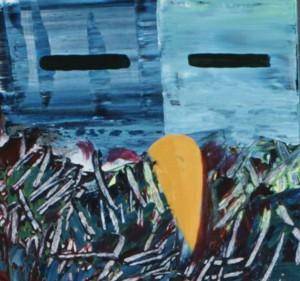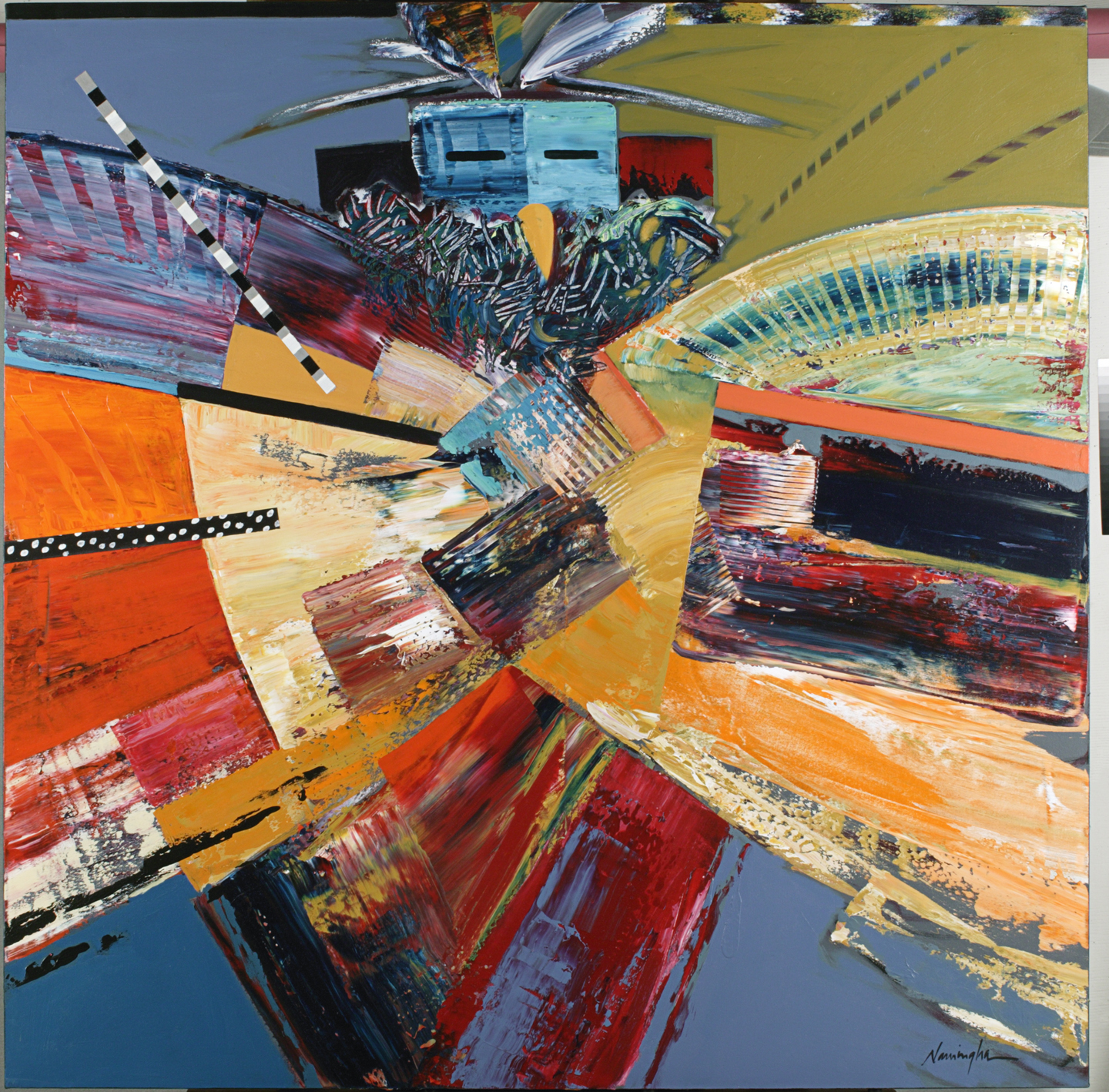This lesson invites students to learn and apply formal methods of visual arts analysis to investigate and understand Dan Namingha’s Hopi Eagle Dancer. They will then experiment with paints in an effort to get a sense of how the artist used different tools and thicknesses of paints to achieve varying effects in the painting.
Students will be able to:
- identify at least three different techniques/characteristics of the painting;
- discuss the impact of the artist’s use of color in the painting;
- list and apply methods of formal visual analysis; and
- use trial-and-error methods to obtain different visual effects.
Lesson
Day 1
- Warm-up: Ask the students what they ate for dinner last night. Have them write down as many different ingredients from the dinner as they can, as well as a description of the dinner’s colors, smells, textures, and flavors. Have them share their observations and descriptions with a partner.
- Tell students that you are going to use the same powers of observation to analyze a painting.
- Share the painting with the students. Using the About the Art section, discuss the artist’s background and a little bit about the methods he used. Save the information about the role of the Eagle Kachina to use a little bit later.
- Teach the children the different methods listed below that are used to analyze a work of art. Either in a handout or written for everyone to see, go over each method and explain the activities they will engage in to practice them. Share that many of their answers and impressions will be different; that there is no one “right” answer. They may work individually at first and then in pairs or larger groups.
- Descriptive method: Have students describe what they see in the painting without drawing conclusions. They can start with the subject matter of the painting and then elaborate.
- Formal analysis method: Have students sketch the image in a journal or on a piece of paper, paying attention to the line, shapes, shading, and other formal characteristics they see (How many different lines? How many different colors?).
- Reflection method: Have students write down the tone, mood, and overall sense they get when looking at the painting. Encourage them to use nouns, verbs, adverbs, and adjectives throughout the process.
- Direct a large-group discussion about what students discovered when analyzing the piece. At this point, you may want to share and discuss information about the Eagle Kachina from the “Details” tab of the About the Art section. For example, you can discuss with students if they think Namingha’s painting reflects the Eagle Kachina’s role as an intermediary between the physical world and the spirit world, and how.
Day 2
- Warm-up: Have the students stand up and get ready to move around the room. Tell them to find something rough to touch and then touch it; repeat, using the following descriptors (and those of your own): smooth, blue, crinkly, red, cold, wavy, black, bumpy, and slippery.
- Revisit the painting and have students call out some of their observations from the day before.
- Tell the students that they are going to experiment with paints to try and create some of the same effects (color, texture, line, and form) that the artist does in the painting, as well as their own, unique effects. They should be prepared to talk about how their pieces are similar and different, as well as what they were trying to achieve.
- On prepared surfaces, set the students up with their paper/canvas, paints, and other assorted tools. As the students work with thick paints and a variety of tools (combs, rulers, brushes, etc.), brainstorm on how the artist created the effects he did. Give them time to really experiment and have “aha!” moments as they work with the paints.
- In small groups, or as a class, allow students to share what they were thinking as they painted, as well as what they discovered when working with the paints and different tools. You may ask them to share their favorite and least favorite things about their piece, as well as what was easiest or hardest about making the painting. Also ask what they would do differently next time.
Materials
- Paper or journals for each student to write down thoughts
- Paint mixed to a thick consistency; acrylics if possible (at least the 3 primary colors, plus others that you have on hand)
- Assorted paintbrushes of different thicknesses
- Assorted tools to scrape and move the paint (e.g. combs, toothbrushes, etc.)
- One or two 11 x 14 inch sheets of paper or treated canvas for each student
- Newspapers or other materials to cover work areas
- Cups with water to wash brushes
- Power towels or rags to dry off brushes between different colors
- About the Art section on Hopi Eagle Dancer (included with the lesson plan)
- One color copy of the painting for every four students, or the ability to project the image onto a wall or screen
Standards
- Visual Arts
- Invent and Discover to Create
- Observe and Learn to Comprehend
- Relate and Connect to Transfer
- Envision and Critique to Reflect
- Language Arts
- Oral Expression and Listening
- Collaboration
- Critical Thinking & Reasoning
- Information Literacy
- Invention
- Self-Direction

Hopi Eagle Dancer
Dan Namingha, United States
1995
Height: 36 in. Width: 36 in.
Denver Art Museum Collection: Gift of Virginia Vogel Mattern, 2003.1296
Photograph © Denver Art Museum 2009. All Rights Reserved.
Dan Namingha is a member of the Hopi tribe and was born in Arizona on the Hopi Reservation in 1950. He was raised by his grandparents while his mother worked as a nurse off the Reservation. Namingha comes from a long line of artists and his family encouraged his experiences with art from a young age. His mother, Dextra, is now a full-time potter and his great-great-grandmother, Nampeyo, was a famous Hopi potter. Though he credits his mother and grandmother for his artistic lineage, he also distinguishes himself as an artist. “I am an extension of them. I am also an experimenter. I am constantly seeking and finding new avenues of expression, but always remaining within the themes I’ve been working with: architecture, landscape, and spiritual imagery.”
Namingha received formal art training from the University of Kansas, the Institute of American Indian Arts in Santa Fe, and the American Academy of Art in Chicago. He now lives in Santa Fe where he and his family operate Niman Fine Art Gallery.
As a child, Namingha often attended Hopi ceremonies with his grandfather, Emerson Namingha. He says that the kachina [kuh-CHEE-nuh] ceremonies left the most lasting impression on him. He attended his first kachina ceremony with his grandfather when he was seven or eight years old:
"I was mesmerized by the appearance of the kachina dancers and their chanting as they moved. My grandfather explained to me that they came from the mountains west of Hopi known as the San Francisco Peaks. They were spirit messengers representing goodness, clouds for moisture, and a blessing for the people. He told me there are more than one hundred different kinds of kachinas, each representing something important in our lives, such as rain, snow, plant life, and animals."
In this painting, Namingha represents the movement, color, and energy of an eagle kachina dancer.
As an artist, Namingha blends contemporary art practices with his Hopi heritage through energetic brushstrokes and bright colors. While serving in the U.S. Marine Corps, he reached an important realization with regards to his artwork: “My time in the Corps gave me precious opportunity to think. I spent hours analyzing what my art should become, and one day it just came to me. Suddenly, I knew that my artistic mission was to transform the subject matter of Native American art and its customary realism into an abstract, almost minimal, form.”
Details

Eagle Kachina
The eagle represents strength and is an important part of the Hopi spiritual world. The Eagle Kachina acts as an intermediary between the physical world and the spirit world. Namingha’s eagle kachina stretches beyond the boundaries of the canvas—the feathers of the headdress are cut off at the top and the wings extend beyond the right and left sides.

Feathers
Eagle feathers are used for healing purposes, prayer offerings, and in ceremonial dances.

Abstraction
Namingha simplifies the form of the eagle kachina with his broad, quick brushstrokes. He gives the idea of the figure without using clear forms or outlines.

Movement
Namingha combined brilliant colors and quick brushstrokes to suggest the movement, energy, and strength of the Eagle Kachina dance.

Texture
Notice the areas where it appears that Namingha has used different tools to move the paint around the canvas. He rakes plaster trowels over wet paint to create different textures.
Funding for object education resources provided by a grant from the Morgridge Family Foundation. Additional funding provided by the William Randolph Hearst Endowment for Education Programs, and Xcel Energy Foundation. We thank our colleagues at the University of Denver Morgridge College of Education.
The images on this page are intended for classroom use only and may not be reproduced for other reasons without the permission of the Denver Art Museum. This object may not currently be on display at the museum.







